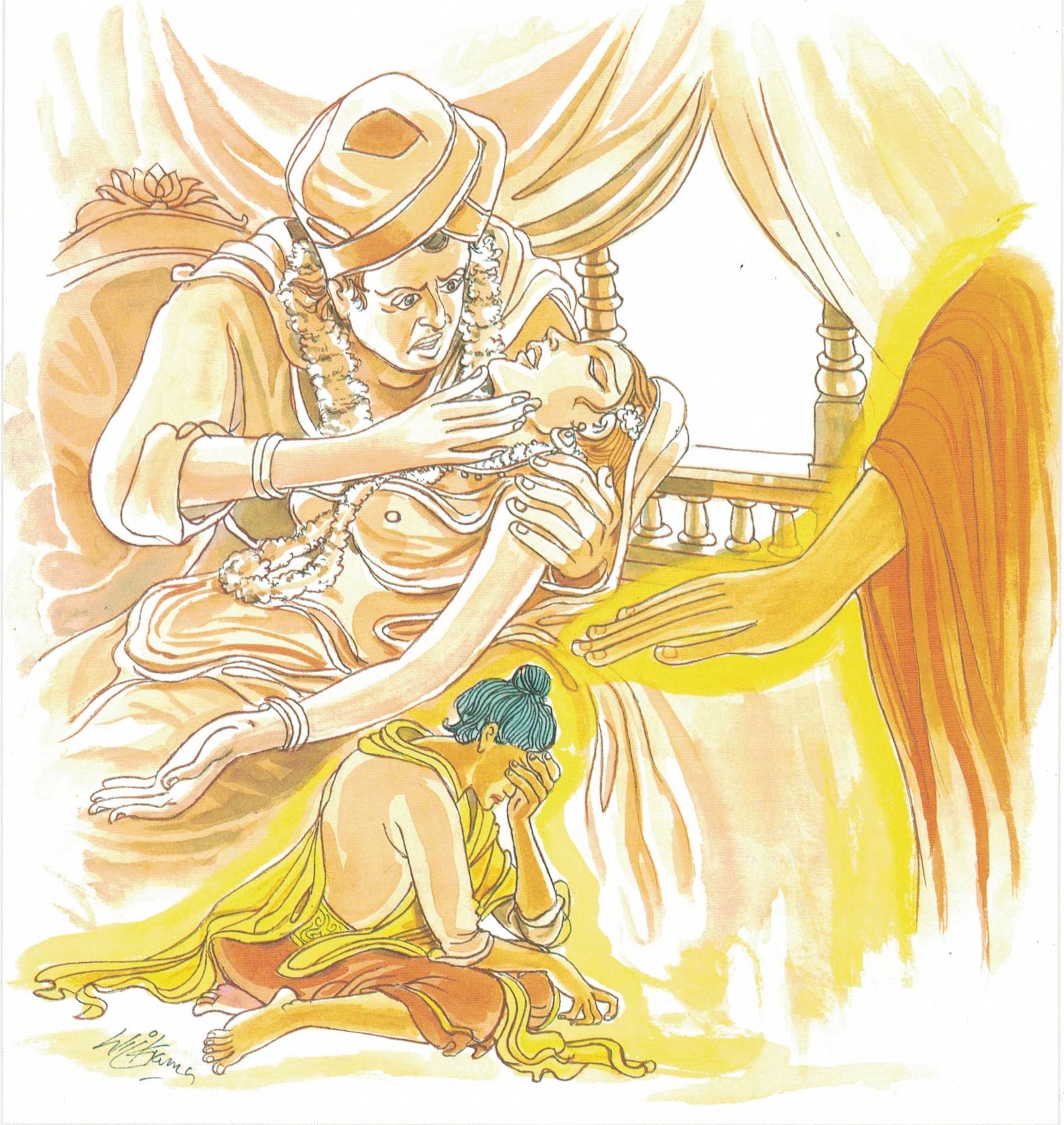Dhammapada (Illustrated)
by Ven. Weagoda Sarada Maha Thero | 1993 | 341,201 words | ISBN-10: 9810049382 | ISBN-13: 9789810049386
This page describes The Story of Anitthigandha Kumara which is verse 215 of the English translation of the Dhammapada which forms a part of the Sutta Pitaka of the Buddhist canon of literature. Presenting the fundamental basics of the Buddhist way of life, the Dhammapada is a collection of 423 stanzas. This verse 215 is part of the Piya Vagga (Affection) and the moral of the story is “From lust, grief and fear arise. To the lust-less, no grief or fear”.
Verse 215 - The Story of Anitthigandha Kumāra
Pali text, illustration and English translation of Dhammapada verse 215:
kāmato jāyatī soko kāmato jāyatī bhayaṃ |
kāmato vippamuttassa natthi soko kuto bhayaṃ || 215 ||
215. From attachment grief is born, from attachment fear, one who is attachment-free has no grief—how fear?
 From lust, grief and fear arise. To the lust-less, no grief or fear. |
The Story of Anitthigandha Kumāra
While residing at the Jetavana Monastery, the Buddha spoke this verse with reference to a youth named Anitthigandha.
Anitthigandha, we are told, passed from the World of Brahma and was reborn in Sāvatthi into a family possessed of great wealth. From the day of his birth he refused to go near a woman. When he reached manhood his mother and father said to him, “Son, we wish to arrange a marriage for you.” The youth replied, I have no use for a woman.” Time and again they asked him, and time and again he refused. Finally he caused five hundred goldsmiths to make a solid image of beaten gold in the form of a woman of surpassing beauty and said to his parents, “If you will bring me such a maiden as that, I will do your bidding.” So saying, he pointed to the image of gold. So his mother and father summoned several noted Brāhmins and sent them forth, saying, “Our son possesses great merit; there must certainly be a maiden who wrought works of merit with him. Take this image of gold with you, go abroad, and bring back with you a maiden of equal beauty.” “Agreed,” said the Brāhmins, and they travelled from place to place until they came to the city Sāgala in the kingdom of Madda.
Now there lived in this city a certain maiden of about sixteen years of age, and she was exceedingly beautiful. The Brāhmins set the golden image down by the side of the road leading to the bathing-place. When the nurse of that maiden saw the image, she said to herself, “I thought this was my own daughter; pray what can this be?” Then the Brāhmins asked her, “Woman, does your daughter look like this image?” “What does this image amount to, compared with my daughter?” ‘Well then, show us your daughter.” The nurse accompanied the Brāhmins to the house. The mistress and master of the household exchanged friendly greetings with the Brāhmins, and then caused their daughter to come down and stand on the lower floor of the palace beside the golden image. So great was the beauty of the maiden that the image no longer seemed beautiful. The Brāhmins gave them the image, took the maiden, and went to inform the mother and father of Anitthigandha Kumāra. Delighted at heart, they said to the Brāhmins, “Go fetch this maiden hither with all speed.” So saying, they were sent forth with rich offerings. When Anitthigandha Kumāra heard the report he said, “Let them fetch the maiden hither with all speed.” The maiden entered a carriage, but so delicate was she that as she was being conveyed along the road, the jolting of the carriage gave her cramps, and she died. When the death was reported to the youth, he exclaimed, “Alas, to think that I should have failed to meet so beautiful a woman!” Profound melancholy came over him, and he was overwhelmed with grief and pain.
The Buddha, seeing that he was ripe for conversion, stopped at the door of his house on his round for alms. He was invited in for a meal by the youth’s parents. At the end of the meal, the Buddha asked of the youth, “Youth, you seem to be very sad.” “Yes, Venerable,” replied the youth, “a most beautiful woman just died upon the road, and the news of her death has made me very sad;so great is my sadness that even my food does not agree with me.” Then said the Buddha to him, “But, youth, do you know the cause of the intense sorrow which has afflicted you?” “No, Venerable, I do not.” “Youth, because of love, intense sorrow has come upon you; sorrow and fear both spring from love.”
Explanatory Translation (Verse 215)
kāmato soko jāyatī kāmato bhayaṃ jāyatī
kāmato vippamuttassa soko natthi bhayaṃ kuto
kāmato [kāmata]: because of passion; soko: sorrow; jāyatī: is born; kāmato [kāmata]: because of passion; bhayaṃ [bhaya]: fear; jāyatī: arises; kāmato vippamuttassa: to one free of passion; soko natthi: there is no sorrow; bhayaṃ [bhaya]: fear; kuto: how can there be?
From desire arises sorrow. From desire fear arises. To one free of desire there is no sorrow. For such a person how can there be fear?
Commentary and exegetical material (Verse 215)
Special Note: The story of Prince Anitthigandha has a remarkable similarity to the story of King Kusa. In this story though, unlike in the Kusa story, the prince is extremely handsome. The parallel occurs in the making of a golden image of a woman depicting the ideal of feminine beauty, in terms of the prince’s vision. In this story as well as in the Kusa episode, the prince, seeking the ideal bride, sends out Brāhmins with a golden effigy. But in this story a beauty is discovered matching the golden image, the episode ends in tragedy, as the bride dies on the way to see the prince.
